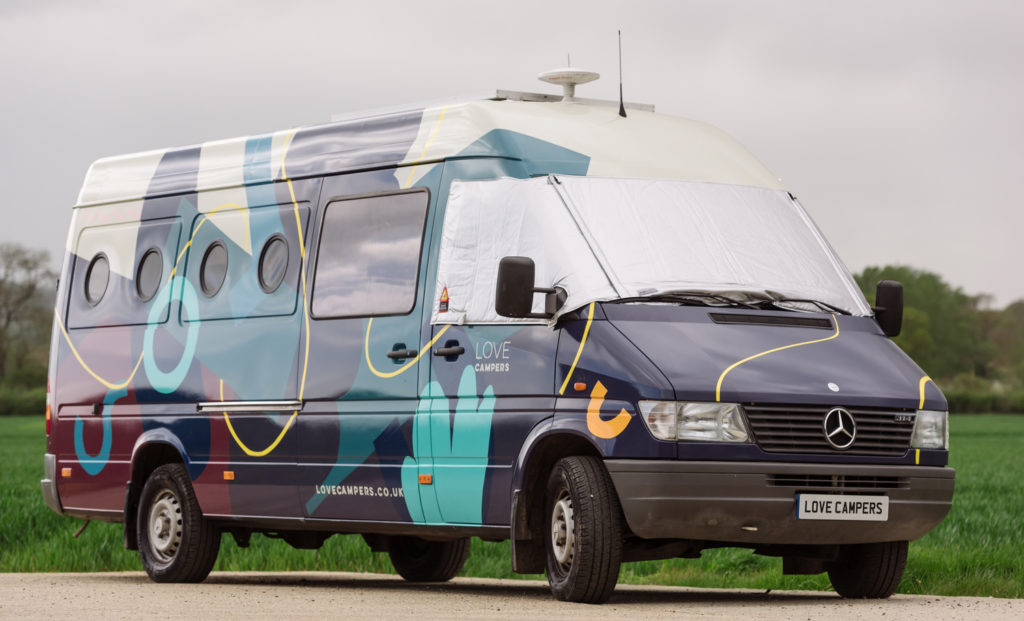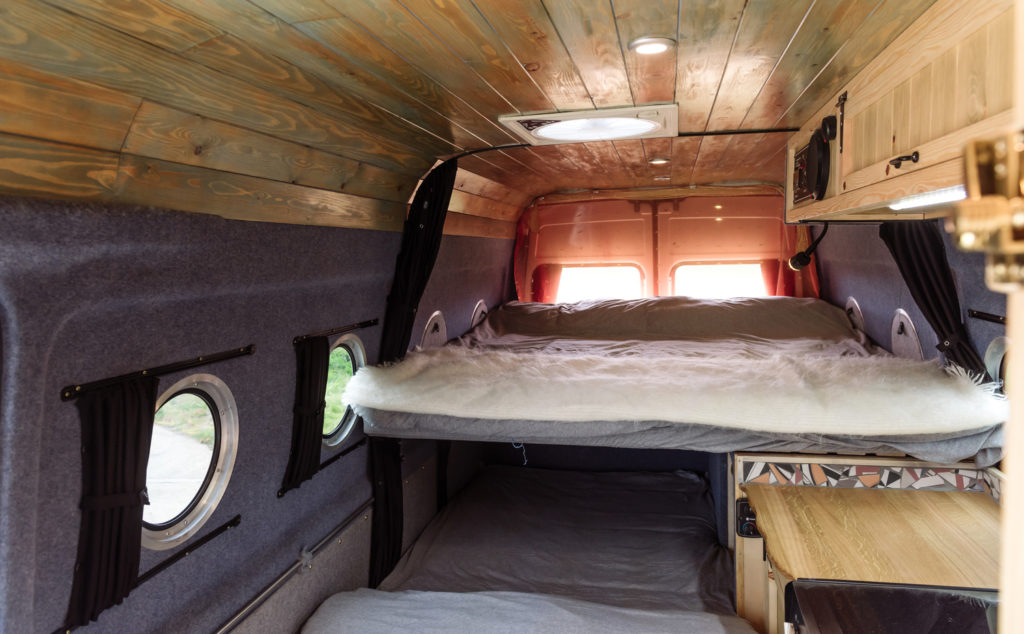As you know, we are constantly researching ways to reduce our carbon footprint and build a low-carbon, eco camper.
We are not looking at developing and marketing an environmentally friendly campervan as one separate option, but finding ways to evolve so that all of our campers, and our entire workshop, are as carbon neutral and environmentally friendly as possible.
Furthur was our first attempt at building a high-performance, low carbon campervan. It is by no means perfect, but we live in an imperfect world, at a transitional time. We explain below, what choices we made, and why.
Why we chose the Mercedes Sprinter for our eco camper
A huge amount of carbon is generated in the initial building of a vehicle. For this reason, we chose to look for an older vehicle, that we could restore and repurpose.
In the end, we found a 2006 Mercedes Sprinter that had been used by a Children’s Circus in Switzerland, before being driven to the UK by a motorbike enthusiast, who used it to transport his motorbike collection.

The Engine – Petrol or Diesel?
There is currently no perfect low carbon option for most campervan users, especially those driving larger vehicles such as our Sprinter.
We chose to search for a petrol- engined vehicle only, with the idea that we would then convert the engine to optionally run on propane gas, sometimes known as LPG. It’s still a fossil fuel, so not exactly a silver bullet when it comes to the environment. However, LPG fuelled vehicles do emit very low emissions when they are being run, so from that perspective, it’s arguably the least worst option.
It is hard to find larger vans with petrol engines, but we did find one in the end. We had the engine converted to run on LPG before we started the conversion. You can find out more about the pros and cons of running a vehicle on LPG fuel.
Off grid & renewable solar power
We wanted to set this van up so it could run completely off-grid, powered only by its own solar panels. We added some powerful solar panels and connected them up to two leisure batteries. In this way, except during the darkest part of the year, the entire campervan system can be powered from clean solar electricity, without being plugged into the mains. This includes a relatively large fridge, all the lighting and USB ports, the water pump, router, and TV.

Eco flooring options for your camper
Flooring is inherently difficult to repurpose or can be prohibitively expensive. After doing some research we went with flooring made by Forbo, a company with a strong environmental policy.
Areas for improvement
As you can see, our work on “greening” our campervan designs is very much a work in progress. There are several areas we have identified for improvement following our first attempt with Furthur.
These include:
Ensuring that all the wood we use is either reclaimed, or from a fully sustainable source.
Because of weight issues in campervans, it is usually not advisable to build the cabinets fully from solid wood, which means that using 100% reclaimed wood is probably not a viable option.
Ensuring that plywood, which is the basis for all the laminates used in campervan builds, and the beautiful stained wood finishes we build in our vans.
We are currently working with our suppliers so that we can be sure we only use fully FSC certified plywood or, an FSC certified alternative.
Finding a cost-effective biodegradable alternative to the foam we currently use in our beds.
The foam we currently use for our upholstery, is not biodegradable. Have a read of this article ‘Polyurethane foam and the environment‘ if you are interested in further information about this.
We are researching biodegradable alternatives, such as natural latex foam, but have not yet identified an option that is within the cost range we think will be acceptable to our customers.
Finding a lower carbon alternative to propane powered kitchen hobs and campervan heating.
Obviously, whilst we are running our engine on gas, it’s slightly inconsistent to then say we are urgently looking for ways to avoid using propane elsewhere in the van.
Although in their campervan related usage, these gas fuelled appliances emit little to no greenhouse gases, the fact remains that propane is a fossil fuel, and ultimately we would like to run a van powered entirely by renewable energy and using sustainable materials.
We are aware that there are some electric campervan hobs on the market, that supposedly run off the leisure battery. We don’t think these are a viable option, especially for off-grid campervanning, as there is no way that a solar panel could generate enough energy for this to work for any length of time.
There are however, many fun, low carbon alternatives to cooking on your campervan gas hob, something we will be exploring in a future blog.
The same goes for the heating. We haven’t found a viable alternative to fossil fuel powered campervan heating, other than wearing an extra jumper! There’s a lot more to this than even the above, so keep reading our blogs if you would like to remain updated on our journey towards fully green campervans.
We continue to research ways to reduce our carbon footprint when building our campervans. If you’d like to talk to Love Campers in more detail about how we build low-carbon, eco campers, why not contact us on hello@lovecampers.co.uk – or follow us on Facebook.
Thanks for reading the post! You might also be interested in:
- VW ID Buzz Surf Campervan of the Future!
- Ambulance campervan conversion – final photos!
- How to choose a ULEZ-compliant campervan for city living
Follow us on our Facebook and Instagram accounts for our latest news and posts!
